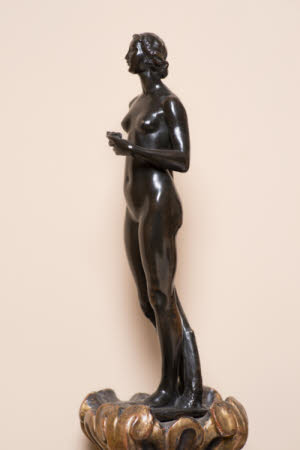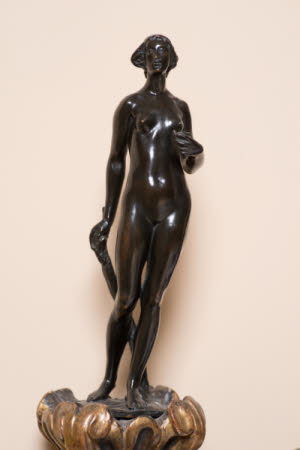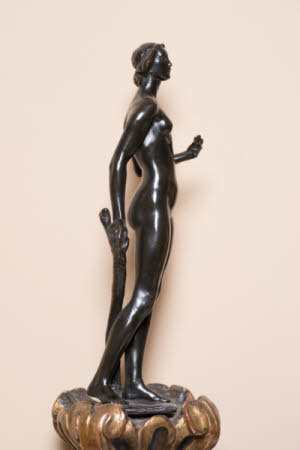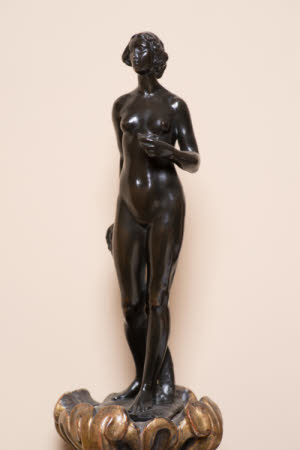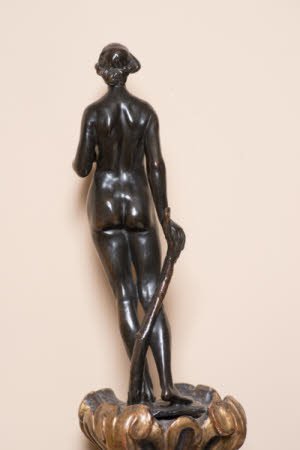Figure of a woman, 'Truth'
Francis Derwent Wood (Keswick 1871 - London 1926)
Category
Art / Sculpture
Date
1913 (model) - 1913 - 1929 (cast)
Materials
Bronze
Measurements
322 x 93 mm
Place of origin
United Kingdom
Order this imageCollection
Anglesey Abbey, Cambridgeshire
NT 515100
Summary
Bronze, figure of a woman, ‘Truth’, Francis Derwent Wood (1871-1926), model 1913, this cast between 1913 and 1929. A bronze statuette by Francis Derwent Wood of a naked female standing figure, ‘Truth’, holding in her cupped left hand an oil lamp, and in her right a staff or a tree trunk. A maquette for a full-size figure in bronze, a cast of which is today in Bristol City Museum and Art Gallery. The statuette and a male figure of David, also by Francis Derwent Wood (NT 515099), were bought by Lord Fairhaven from the sculptor’s widow.They have always been treated as a pair at Anglesey Abbey, and are today displayed mounted as bedposts on Lord Fairhaven’s bed. On an integral rectangular base.
Full description
The bronze statuette is a cast made for Francis Derwent Wood himself of a major composition which he entitled Truth, and which he exhibited at the Royal Academy in 1914 (no. 2046), in the form of the plaster model. A large-scale cast in bronze, signed and dated 1913, now in the Bristol City Museum and Art Gallery (Inv. L290; Withey 2015, p. 108, no. 125), was exhibited in the memorial exhibition to Derwent Wood and Hamo Thorneycroft held at the Royal Academy early in 1927 (Exhibition of Works by the late Sir Hamo Thornycroft, R.A. and F. Derwent Wood, R.A., p. 16, no. 84, lent by Mrs Derwent Wood). The figure carries an oil lamp symbolising the spirit of Truth, a concept that appears in the Bible, but was revived by John Ruskin in his influential treatise The Seven Lamps of Architecture (1849), in which the second chapter, dealing with the importance of honesty in materials and construction methods, is entitled ‘The Lamp of Truth’. Another cast of the large-size model was ordered by Mrs Wood from the Compagnie des Bronzes in Brussels, which seems to have done much of Derwent Wood’s casting in the 1920s, and invoiced on 4 December 1926 (Los Angeles, Getty Research Institute, 860605-8). It is not known when the small bronze figure of Truth now at Anglesey Abbey was cast. Lord Fairhaven bought it and an accompanying figure, a maquette of the figure of David for Francis Derwent Wood’s final and most famous work, the Machine Gun Corps Memorial at Hyde Park Corner (NT 515099), directly from Mrs Florence Derwent Wood (1873-1969), the widow of the sculptor. The purchase must have been made some time between 1929, when Urban Broughton was created first Baron Fairhaven following the death of his father, and before 1932, when both figures are listed in an inventory of the works of art at Anglesey Abbey. A letter from Mrs Wood in the archives at Anglesey, dated 15 January but unfortunately without the year specified, addresses the recipient as Lord Fairhaven and thanks him for purchasing the two statuettes, Florence Derwent Wood adding that ‘I hope they will give you as much pleasure to live with as they have given me hitherto.’ The sale seems to have been mediated by an ‘Oswald’, quite conceivably the painter Sir Oswald Birley (1880-1952), who painted both Lord Fairhaven and his mother Cara in 1925 (NT 515465 and 515466). In the course of her letter, Mrs Wood confirmed that ‘the “David” and the “Truth” I am sending you are the first casts from the small models for the two large statues of the same name.’ She also commented that ‘Oswald told me that you like the large “Truth” & I told him I wanted £1,000 for it as it was the only cast yet made of it, but in view of the fact that you have purchased these small “David” and “Truth” & should you consider it later on you could have it for £750.’ This may be the cast ordered by Mrs Wood in 1926. Jeremy Warren 2020
Provenance
Acquired by Urban Huttleston Rogers Broughton, 1st Lord Fairhaven (1896-1966) before 1932; identifiable in the Anglesey Abbey inventory of 1932, p. 38, Newmarket Room, valued at £40 together with its companion figure; identifiable in the Anglesey Abbey inventory of 1940, Newmarket Room, valued at £40 together with its companion figure; bequeathed to the National Trust in 1966 by Lord Fairhaven with the house and the rest of the contents.
Credit line
Anglesey Abbey, The Fairhaven Collection (The National Trust)
Makers and roles
Francis Derwent Wood (Keswick 1871 - London 1926) , sculptor
References
Withey 2015: Matthew Withey, The Sculpture of Francis Derwent Wood, British Sculptors and Sculpture Series, London 2015 Exhibition of Works by the late Sir Hamo Thornycroft, R.A. and F. Derwent Wood, R.A., Royal Academy of Arts, London, 13 January 1927 to 5 March 1927, p. 8, no. 13. ‘Anglesey Abbey, Lode, Cambridgeshire. An Inventory and Valuation of Furniture, Pictures, Ornamental Objects, Household Effects and A Collection of Miniatures.. prepared for Insurance Purposes’, Turner, Lord and Ransom, November 1932, p. 38. 'Anglesey Abbey, Lode, Cambridgeshire. An Inventory and Valuation of Furniture, Books, Ornamental Items & Household Effects .. prepared for Insurance Purposes’, Turner, Lord and Ransom, April 1940, p. 32. Christie, Manson & Woods 1971: The National Trust, Anglesey Abbey, Cambridge. Inventory: Furniture, Textiles, Porcelain, Bronzes, Sculpture and Garden Ornaments’, 1971, p. 151, The Newmarket Room.
